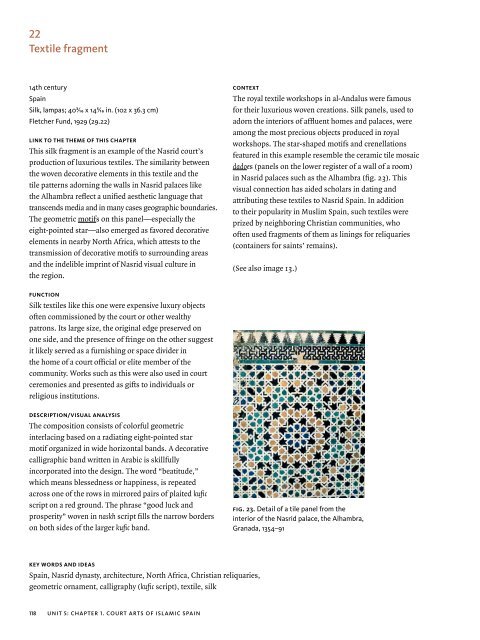Courtly Splendor in the Islamic World - The Metropolitan Museum of ...
Courtly Splendor in the Islamic World - The Metropolitan Museum of ...
Courtly Splendor in the Islamic World - The Metropolitan Museum of ...
Create successful ePaper yourself
Turn your PDF publications into a flip-book with our unique Google optimized e-Paper software.
22<br />
textile fragment<br />
14th century<br />
Spa<strong>in</strong><br />
Silk, lampas; 403⁄16 x 145⁄16 <strong>in</strong>. (102 x 36.3 cm)<br />
Fletcher Fund, 1929 (29.22)<br />
LInK to <strong>the</strong> <strong>the</strong>me <strong>of</strong> thIs Chapter<br />
This silk fragment is an example <strong>of</strong> <strong>the</strong> Nasrid court’s<br />
production <strong>of</strong> luxurious textiles. <strong>The</strong> similarity between<br />
<strong>the</strong> woven decorative elements <strong>in</strong> this textile and <strong>the</strong><br />
tile patterns adorn<strong>in</strong>g <strong>the</strong> walls <strong>in</strong> Nasrid palaces like<br />
<strong>the</strong> Alhambra reflect a unified aes<strong>the</strong>tic language that<br />
transcends media and <strong>in</strong> many cases geographic boundaries.<br />
<strong>The</strong> geometric motifs on this panel—especially <strong>the</strong><br />
eight-po<strong>in</strong>ted star—also emerged as favored decorative<br />
elements <strong>in</strong> nearby North Africa, which attests to <strong>the</strong><br />
transmission <strong>of</strong> decorative motifs to surround<strong>in</strong>g areas<br />
and <strong>the</strong> <strong>in</strong>delible impr<strong>in</strong>t <strong>of</strong> Nasrid visual culture <strong>in</strong><br />
<strong>the</strong> region.<br />
funCtIon<br />
Silk textiles like this one were expensive luxury objects<br />
<strong>of</strong>ten commissioned by <strong>the</strong> court or o<strong>the</strong>r wealthy<br />
patrons. Its large size, <strong>the</strong> orig<strong>in</strong>al edge preserved on<br />
one side, and <strong>the</strong> presence <strong>of</strong> fr<strong>in</strong>ge on <strong>the</strong> o<strong>the</strong>r suggest<br />
it likely served as a furnish<strong>in</strong>g or space divider <strong>in</strong><br />
<strong>the</strong> home <strong>of</strong> a court <strong>of</strong>ficial or elite member <strong>of</strong> <strong>the</strong><br />
community. Works such as this were also used <strong>in</strong> court<br />
ceremonies and presented as gifts to <strong>in</strong>dividuals or<br />
religious <strong>in</strong>stitutions.<br />
desCrIptIon/VIsuaL anaLysIs<br />
<strong>The</strong> composition consists <strong>of</strong> colorful geometric<br />
<strong>in</strong>terlac<strong>in</strong>g based on a radiat<strong>in</strong>g eight-po<strong>in</strong>ted star<br />
motif organized <strong>in</strong> wide horizontal bands. A decorative<br />
calligraphic band written <strong>in</strong> Arabic is skillfully<br />
<strong>in</strong>corporated <strong>in</strong>to <strong>the</strong> design. <strong>The</strong> word “beatitude,”<br />
which means blessedness or happ<strong>in</strong>ess, is repeated<br />
across one <strong>of</strong> <strong>the</strong> rows <strong>in</strong> mirrored pairs <strong>of</strong> plaited kufic<br />
script on a red ground. <strong>The</strong> phrase “good luck and<br />
prosperity” woven <strong>in</strong> naskh script fills <strong>the</strong> narrow borders<br />
on both sides <strong>of</strong> <strong>the</strong> larger kufic band.<br />
Key Words and Ideas<br />
118<br />
Context<br />
Spa<strong>in</strong>, Nasrid dynasty, architecture, North Africa, Christian reliquaries,<br />
geometric ornament, calligraphy (kufic script), textile, silk<br />
unit 5: chapter 1. court arts <strong>of</strong> islamic spa<strong>in</strong><br />
<strong>The</strong> royal textile workshops <strong>in</strong> al-Andalus were famous<br />
for <strong>the</strong>ir luxurious woven creations. Silk panels, used to<br />
adorn <strong>the</strong> <strong>in</strong>teriors <strong>of</strong> affluent homes and palaces, were<br />
among <strong>the</strong> most precious objects produced <strong>in</strong> royal<br />
workshops. <strong>The</strong> star-shaped motifs and crenellations<br />
featured <strong>in</strong> this example resemble <strong>the</strong> ceramic tile mosaic<br />
dadoes (panels on <strong>the</strong> lower register <strong>of</strong> a wall <strong>of</strong> a room)<br />
<strong>in</strong> Nasrid palaces such as <strong>the</strong> Alhambra (fig. 23). This<br />
visual connection has aided scholars <strong>in</strong> dat<strong>in</strong>g and<br />
attribut<strong>in</strong>g <strong>the</strong>se textiles to Nasrid Spa<strong>in</strong>. In addition<br />
to <strong>the</strong>ir popularity <strong>in</strong> Muslim Spa<strong>in</strong>, such textiles were<br />
prized by neighbor<strong>in</strong>g Christian communities, who<br />
<strong>of</strong>ten used fragments <strong>of</strong> <strong>the</strong>m as l<strong>in</strong><strong>in</strong>gs for reliquaries<br />
(conta<strong>in</strong>ers for sa<strong>in</strong>ts’ rema<strong>in</strong>s).<br />
(See also image 13.)<br />
Fig. 23. Detail <strong>of</strong> a tile panel from <strong>the</strong><br />
<strong>in</strong>terior <strong>of</strong> <strong>the</strong> Nasrid palace, <strong>the</strong> Alhambra,<br />
Granada, 1354–91

















